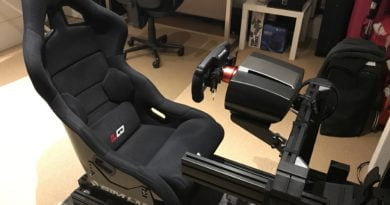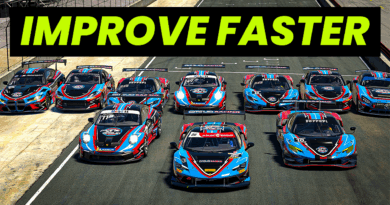5 Common Causes of Understeer in Sim Racing (And How to Fix Them)
Understeer is one of the most frustrating problems a sim racer can face. You turn the wheel, but instead of the car rotating toward the apex, it pushes wide and refuses to follow the intended line. It robs you of entry precision, kills mid-corner speed, and leaves you slow and off-balance on corner exit.
The good news is that understeer isn’t random—it has clear, identifiable causes that can be corrected once you know where to look. By understanding the most common mistakes that lead to understeer and applying the right fixes, you can unlock better cornering balance, preserve your tires, and gain confidence in every phase of the lap. I’m Marian Barbieru and I’ve coached both sim racers and real life drivers. I’ve seen these issues appear over and over again, and I can tell you that once you learn how to manage them, your driving will feel smoother, more precise, and ultimately much faster.

1. Braking Too Late
The mistake: Overcooking the entry by braking too late overloads the front tires. By the time you try to turn, they’re already past their grip limit and the car refuses to rotate.
How to fix it: Prioritize consistent, slightly earlier braking. Use trail braking to gradually release pressure as you turn in, keeping weight over the front axle and allowing the car to rotate smoothly.
2. Turning In Too Early
The mistake: An early turn-in leads to a shallow line that points you toward the outside curb too soon. The car “pushes wide,” forcing you to add extra steering input mid-corner—classic understeer.
How to fix it: Delay your turn-in and aim for a later apex. This opens the entry angle, reduces steering demand, and helps the car rotate naturally with less front-end push.
3. Poor Throttle Timing
The mistake: Getting impatient with the throttle on corner exit shifts weight rearward too early. The front tires lose bite and the car drifts wide, compounding understeer on exit.
How to fix it: Think of throttle as a tool for balance. Apply it progressively only once the car is pointed toward the exit, matching steering wheel unwind.
4. Abrupt Inputs
The mistake: Jerky steering, sudden brake release, or snapping the throttle upsets weight transfer. The load shifts unpredictably, and the front tires can’t generate consistent grip, creating understeer.
How to fix it: Train smoother, more connected inputs. Blend braking, steering, and throttle transitions so the car stays balanced, letting the front end grip more effectively.
5. Setup Imbalances
The mistake: Even with good technique, an unbalanced setup can cause persistent understeer—too much front ARB stiffness, excessive front wing, or brake bias too far forward.
How to fix it: Make setup adjustments that promote front grip and rotation: stiffen the rear ARB or soften the front, shift brake bias slightly rearward, add more negative camber to the front tires, or adjust ride heights/wing settings depending on car type.

Once you dig deeper, you realize understeer is really feedback. It’s the car telling you that your inputs, your line, or even your setup aren’t aligned with the available grip. In other words, it’s not the car fighting back—it’s the car giving you information.
Technically, the solution almost always comes down to balance. Managing weight transfer with smoother brake releases, timing your turn-in so the car rotates on its own, and feeding in throttle progressively so you don’t unload the front tires too early. Fix understeer on entry, and suddenly your mid-corner line opens up. Fix understeer on exit, and you’re carrying more speed onto the straight. That’s why small corrections compound into big gains over a lap or even a full race distance.
This is exactly the philosophy I teach inside the GITGUD Racing Academy and the complete sim racing courses. We go far beyond “just drive smoother”—we break down drills that help you feel weight transfer, exercises that train your brain to react automatically rather than overthink, and structured approaches to qualifying, racing, and long-term improvement. Understeer is only one piece of the puzzle, but once you learn how to correct it consistently, you’ll notice everything else—lap times, tire life, and racecraft—start to click into place.
So the next time you feel the car pushing wide, don’t get frustrated. Stay calm, adjust your technique, and treat the understeer as feedback rather than failure. That shift in both execution and psychology is where real progress happens. The in-depth product reviews here cut through the noise and help you understand not just what’s available, but how each piece of hardware impacts your driving experience. Good technique and the right mindset will always be the foundation, but pairing them with the right tools accelerates your growth and makes every lap more rewarding.
Good hardware will help you feel understeer quicker, and for that I can’t recommend going over the product reviews here on SimRaceBlog. We cut through the noise and help you understand not just what’s available, but how each piece of hardware impacts your driving experience. Good technique and the right mindset will always be the foundation, but pairing them with the right tools accelerates your growth and makes every lap more rewarding.
Marian Barbieru — Sim racing coach, online racing course author, and content creator at GITGUD Racing.
I help sim racers improve lap times, master proper racing techniques, and build consistency in iRacing.




